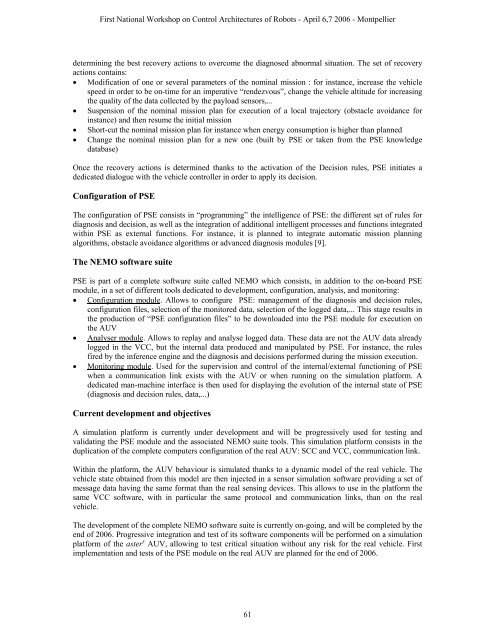Pleading for open modular architectures - Lirmm
Pleading for open modular architectures - Lirmm
Pleading for open modular architectures - Lirmm
Create successful ePaper yourself
Turn your PDF publications into a flip-book with our unique Google optimized e-Paper software.
First National Workshop on Control Architectures of Robots - April 6,7 2006 - Montpellier<br />
determining the best recovery actions to overcome the diagnosed abnormal situation. The set of recovery<br />
actions contains:<br />
• Modification of one or several parameters of the nominal mission : <strong>for</strong> instance, increase the vehicle<br />
speed in order to be on-time <strong>for</strong> an imperative “rendezvous”, change the vehicle altitude <strong>for</strong> increasing<br />
the quality of the data collected by the payload sensors,...<br />
• Suspension of the nominal mission plan <strong>for</strong> execution of a local trajectory (obstacle avoidance <strong>for</strong><br />
instance) and then resume the initial mission<br />
• Short-cut the nominal mission plan <strong>for</strong> instance when energy consumption is higher than planned<br />
• Change the nominal mission plan <strong>for</strong> a new one (built by PSE or taken from the PSE knowledge<br />
database)<br />
Once the recovery actions is determined thanks to the activation of the Decision rules, PSE initiates a<br />
dedicated dialogue with the vehicle controller in order to apply its decision.<br />
Configuration of PSE<br />
The configuration of PSE consists in “programming” the intelligence of PSE: the different set of rules <strong>for</strong><br />
diagnosis and decision, as well as the integration of additional intelligent processes and functions integrated<br />
within PSE as external functions. For instance, it is planned to integrate automatic mission planning<br />
algorithms, obstacle avoidance algorithms or advanced diagnosis modules [9].<br />
The NEMO software suite<br />
PSE is part of a complete software suite called NEMO which consists, in addition to the on-board PSE<br />
module, in a set of different tools dedicated to development, configuration, analysis, and monitoring:<br />
• Configuration module. Allows to configure PSE: management of the diagnosis and decision rules,<br />
configuration files, selection of the monitored data, selection of the logged data,... This stage results in<br />
the production of “PSE configuration files” to be downloaded into the PSE module <strong>for</strong> execution on<br />
the AUV<br />
• Analyser module. Allows to replay and analyse logged data. These data are not the AUV data already<br />
logged in the VCC, but the internal data produced and manipulated by PSE. For instance, the rules<br />
fired by the inference engine and the diagnosis and decisions per<strong>for</strong>med during the mission execution.<br />
• Monitoring module. Used <strong>for</strong> the supervision and control of the internal/external functioning of PSE<br />
when a communication link exists with the AUV or when running on the simulation plat<strong>for</strong>m. A<br />
dedicated man-machine interface is then used <strong>for</strong> displaying the evolution of the internal state of PSE<br />
(diagnosis and decision rules, data,...)<br />
Current development and objectives<br />
A simulation plat<strong>for</strong>m is currently under development and will be progressively used <strong>for</strong> testing and<br />
validating the PSE module and the associated NEMO suite tools. This simulation plat<strong>for</strong>m consists in the<br />
duplication of the complete computers configuration of the real AUV: SCC and VCC, communication link.<br />
Within the plat<strong>for</strong>m, the AUV behaviour is simulated thanks to a dynamic model of the real vehicle. The<br />
vehicle state obtained from this model are then injected in a sensor simulation software providing a set of<br />
message data having the same <strong>for</strong>mat than the real sensing devices. This allows to use in the plat<strong>for</strong>m the<br />
same VCC software, with in particular the same protocol and communication links, than on the real<br />
vehicle.<br />
The development of the complete NEMO software suite is currently on-going, and will be completed by the<br />
end of 2006. Progressive integration and test of its software components will be per<strong>for</strong>med on a simulation<br />
plat<strong>for</strong>m of the aster x AUV, allowing to test critical situation without any risk <strong>for</strong> the real vehicle. First<br />
implementation and tests of the PSE module on the real AUV are planned <strong>for</strong> the end of 2006.<br />
61

















